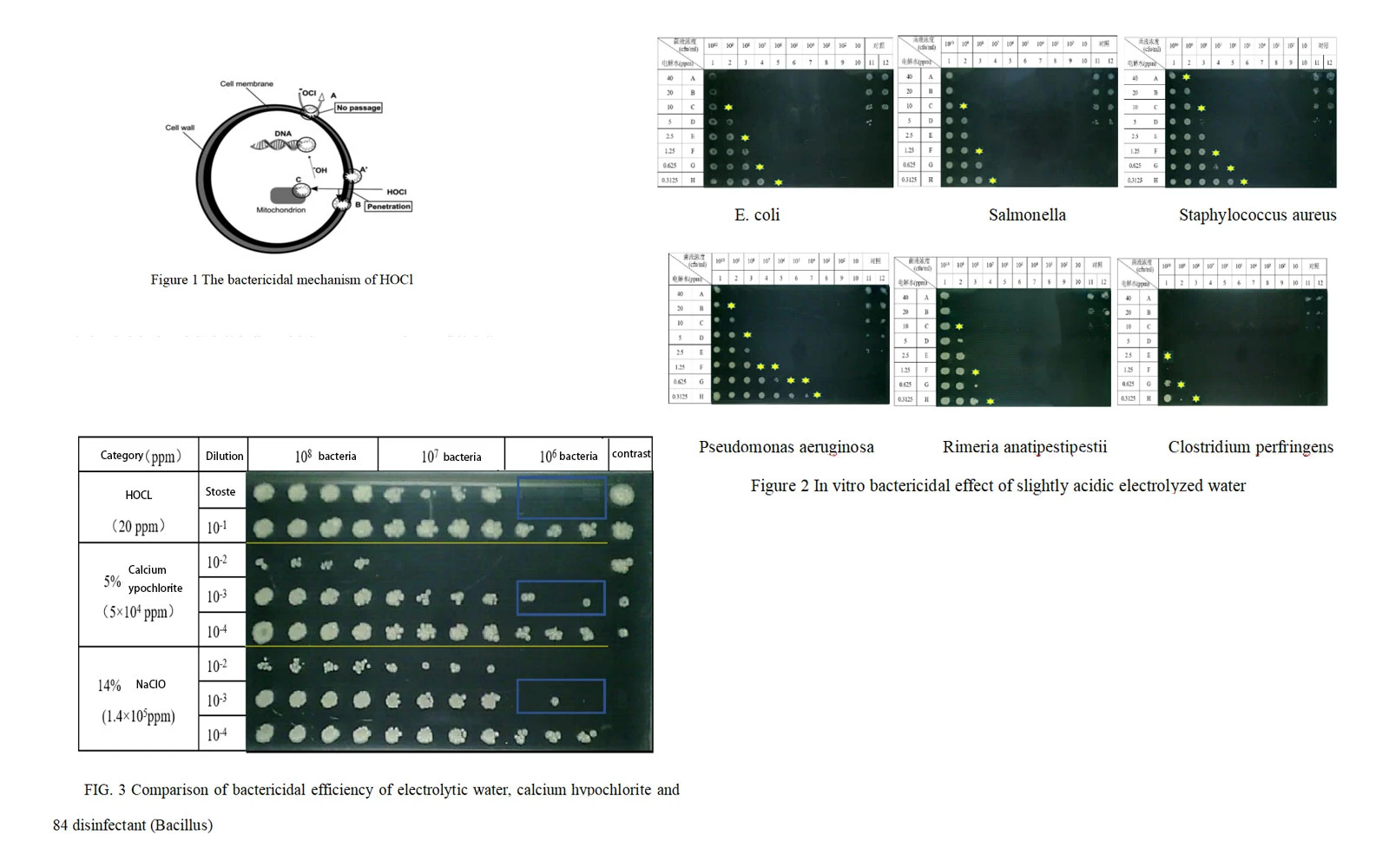Slightly acidic electrolyzed water is a green, environmentally friendly, safe and efficient disinfectant. It has the characteristics of broad-spectrum sterilization, instantaneous efficiency, good stability, convenient production, and low cost. Slightly acidic electrolyze water is produce by non-diaphragm electrolysis. Which is mainly affecte by the Cl- concentration in the water source and the electrolysis time. One of its characteristics is that it is oxidizing and contains reactive oxygen species (ROS). Such as superoxide anion O₂·—, hydroxyl radicals ·OH, hydrogen peroxide H2O2, hypochlorous acid HClO, etc. The main active ingredient is HClO. The second characteristic is that the half-width of the water vibration frequency (expressed in Hertz Hz) is reduced after electrolysis. And the electrolyzed water becomes small water molecule cluster water. Easy to penetrate the cell membrane, with strong penetrability and good solubility.
In 2002, Japan’s Ministry of Health and Welfare recognized acidic electrolyzed water as a food additive. Besides, the U.S. FDA also included hypochlorous acid in the “List of Effective Food Contact Substances.”. My country’s electrolyzed water technology has entered a period of rapid development since 2015. And the application of electrolyzed water has expanded from food, medical and agriculture to public health, livestock breeding and other industries.
Japanese researcher Fukuzaki hypochlorous acid is the main bactericidal component of electrolyzed water. He believes that the surface of the cell membrane is negatively charged. Hypochlorous acid is a neutral small molecule that can penetrate the cell membrane and enter the interior of the cell. And undergo oxidation reactions with internal DNA and mitochondria. Hypochlorite is negatively charged and has the same charge as the cell membrane surface and cannot easily enter the cell (Figure 1). This partly explains the higher sterilization efficiency of electrolyzed water than other hypochlorous acid disinfectants.
The theory of physical sterilization believes that electrolyzed water has a high redox potential (ORP). Which changes the potential of the cell membrane, destroys the balance. And changes the permeability of the cell membrane, causing intracellular substances to leak out and bacterial death. The theory of chemical sterilization believes that slightly acidic electrolyzed water has strong Oxidative components. These substances directly destroy the bimolecular phospholipid layer. Causing the leakage of intracellular proteins and other substances, and damaging the genetic structure. In short, the active ingredients in slightly acidic electrolyzed water act on the outer walls of cells or virus shells. Causing internal substances to overflow, and even penetrate into the interior to directly oxidize proteins and genetic materials, leading to death.
HClO is one of the reactive oxygen species in organisms and is also a product of normal metabolism of body cells. It is form by an enzyme-catalyzed reaction related to heme peroxidase. And, it plays an antibacterial, anti-inflammatory and anti-tumor role within a certain concentration range. It also plays an important role in immunity, helping the body to resist and eliminate invading bacteria and viruses. However, when the HClO content in the body increases abnormally, pathological changes occur in the body, such as causing oxidative stress.

1.In vitro bactericidal effect of slightly acidic electrolyzed water
In view of the current situation of low animal immunity caused by intensive breeding. Drinking water pollution, animal bacterial diseases and antibiotic drug policy adjustments faced by the breeding industry, we explore the safety of slightly acidic electrolyzed water feeding on the growth and development of broiler chickens, and further study the slightly acidic electrolyzed water The effect of water on broiler chickens’ resistance to Salmonella and Clostridium perfringens infection provides experimental data support for the application of slightly acidic electrolyzed water in animal breeding and prevention and control of pathogenic bacteria. The main research progress is as follows:
An in vitro sterilization test was conduct using slightly acidic electroly water on six common pathogenic bacteria: Escherichia coli, Salmonella, Staphylococcus aureus, Pseudomonas aeruginosa, Riemerella anatipestifer and Clostridium perfringens. The results showed that 10 ppm slightly acidic water Electrolyzed water can reduce various pathogenic bacteria by 5-6 orders of magnitude within 5 minutes (see Figure 2). It has a rapid and efficient killing effect. The sterilization efficiency is higher than that of calcium hypochlorite and sodium hypochlorite(Figure 3).
2.Salmonella's effect on chickens
Salmonella: 3-day-old 817 broiler chickens were orally infect with Salmonella Enteritidis to verify the inhibitory effect of drinking 40 ppm slightly acidic electrolyz water on Salmonella in the body. The results show that after being infect with Salmonella, the broiler chickens were lethargic, had severe diarrhea, and the liver show symptoms such as yellowing, congestion, cell degeneration and swelling (Figure 4). The corresponding symptoms in the electrolyzed water group were significantly milder, and 80% of the livers had no obvious lesions.
The bacterial load in the liver decreased significantly, and the antibacterial rate reached 90%; the spleen of the Salmonella group was significantly congested and severely inflamed, and the intestinal villi and mucosal epithelium of the cecum were shed (Figure 5). The electrolyzed water group showed mild congestion and inflammation in the spleen and cecum, and the spleen There were no obvious lesions in the cecum and cecum. SIgA in the cecal mucosa was significantly better than that in the positive group, and harmful bacteria in the intestinal flora were reduce. It shows that drinking electrolyzed water can significantly inhibit the damage caused by Salmonella to the internal organs and intestines of broiler chickens.

Research results show that in vitro tests show that slightly acidic electrolyzed water has broad-spectrum sterilization and instantaneous high efficiency. In vivo tests show that 10-40 ppm electrolyzed water is safe for feeding broilers. And 10-20 ppm slightly acidic electrolyzed water can promote the growth and development of broilers. Effect; In a large-scale broiler pilot test. Drinking 10 ppm slightly acidic electrolyzed water can promote the production performance of white-feathered broilers. Drinking 40 ppm slightly acidic electrolyzed water has a good cure for broiler chickens infected with Salmonella and Clostridium perfringens. Effect. Slightly acidic electrolyzed water has good application potential and development prospects in the animal breeding industry.
